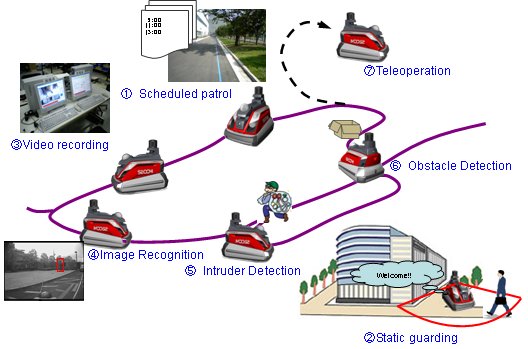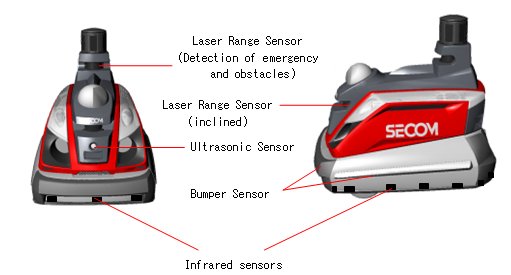|
|
|

|
SECOM has been actively researching and developing various sensing technologies for the rapid detection of emergencies such as fires and intrusions. Through the development these technologies, we have accumulated a large amount of knowledge in these areas.
IS Laboratory is also active on cutting edge research for the key technologies of tomorrow for physical and information security. Research thrusts are concentrated into image recognition as well as other new sensing technologies, biometric authentication technologies such as face, voice and fingerprint and robotic technologies.
Robotic security systems are anticipated to serve as a platform for the realization of a completely new configuration for monitoring as well as promoting new security values, by fusing the technologies that have already been developed, and will be developed at IS Laboratory. In this article, we introduce the concept of robotic security as envisioned by Secom and the key technologies required to develop such a system. |
|
| Introduction |
|
Recently, interest in next generation robots, also known as service robots, has been rising due to events such as:
- Robots competitions held all over the world
- DARPA Grand Challenge and its Japanese version, "Tsukuba Challenge"
- Field trials in the special robot district in Japan
Moreover, through publications such as "Guidelines for the Safe Operation of Next Generation Robots," the Ministry of Economy, Trade and Industry of Japan is preparing to usher in the era of living with robots, with several. robots for domestic use appearing on the market.
In this context, Secom has commercialized two types of robots, "My Spoon", a meal-assistance robot to allow physically disabled people to eat on their own, and "SECOM Robot X", an outdoor patrol robot designed as an alternative to patrolmen, in May 2002 and October 2005, respectively. These robots are equipped with the results of many different studies of the Laboratory, and are also being improved continuously.
 
Fig.1 Robots developed by SECOM (From left, "My Spoon", "SECOM Robot X")
|
| Advantages of using robots and their application to security services |
|
General advantages of using robots include:
- Increased precision, power, speed and effectiveness for tasks
- Increased safety with operating in hazardous areas through teleoperation
- Operate continuously without rest, even for simple, repetitive tasks
In the context of security, especially outdoors, the advantages over the most common methods currently used, fixed sensors and surveillance cameras, include:
- Detect intruders or irregularities more actively than just recording video or images
- Give chase to intruders and gather more video evidence
- Act as a deterrent through patrols of an given area
- Operate in different modes of operation such as large area surveillance, performing different duties such as surveillance or reception depending on schedule and flexibly conform to temporary security requests
- Increase quality of security through the elimination of blind spots caused by environmental changes or malicious intent
New innovative solutions become possible by leveraging the combination of mobile robotics and security.
|
| SECOM Robot X functionality |
|
SECOM Robot X automatically patrols preprogrammed routes registered, in place of human guards. While patrolling, it not only records video, but can also automatically detect intruders, suspicious vehicles, theft and fire. If an emergency is detected, the base station is notified wirelessly. After receiving the notification, the human guards can teleoperate the robot while receiving a realtime video feed. The main functions of the robot are shown in Table 1.
Table.1 Functions of SECOM Robot X
| Function |
Description |
| (1) Scheduled patrol |
Patrol a route marked by magnetic guides on programmed schedule. |
| (2) Static guarding |
Detection of intruders and vehicles entering restricted areas, or detection of visitors. |
| (3) Recording images |
Record video from the omnidirectional and pan-tilt-zoom camera during patrol and static guarding. The omnidirectional camera allows recording of all 360 degrees around the robot and the PTZ camera allows recognition of distant license plates. |
| (4) Image sensing |
Intruder detection by comparison with images registered earlier. |
| (5) Intruder detection |
Detection of intruders, suspicious vehicles, theft with laser range sensors. |
| (6) Safety |
Obstacle and road surface sensing to patrol safely. |
| (7) Teleoperation |
Remote operation to chase intruders and to eliminate blind spots. |

Fig.2 Functions of SECOM Robot X
|
| Key Technologies used in SECOM Robot X |
|
The functionality of SECOM Robot X is derived from the integration of image sensing technologies cultivated at the IS Laboratory will various control and other sensing technologies. The key technologies and their role are listed in the Table 2.

Fig.3 Sensors installed in SECOM Robot X
Table.2 Key Technologies on SECOM Robot X
Technology |
Functionality |
Role/Overview |
Position Detection |
Intruder detection |
Data from the laser range sensor are compared to previous data from the same location.. Functionality is closely intertwined with the robot pose. |
Safety Sensing (Obstacle and surface condition detection) |
Laser range sensor pointed diagonally toward the road surface detect obstacles and surface conditions. Accurate measurement is crucial to detect sudden changes in elevation or obstacles. |
Scheduled patrols
(marker) |
Autonomous movement is required between positions where markers cannot be placed, due to surface elevation changes or surface materials. Also used to return to a marker when a marked section ends. |
Tracking |
Intruder detection |
Detects moving objects by comparison with previous laser range sensor data. False positives or multiple detections minimized by identifying and tracking objects. |
Intruder detection
(visual tracking) |
Utilizes the PTZ camera to record video of intruders identified by the laser range sensor for evidence. |
Static guarding
(Access control)
|
Tracks visitors or vehicles to distinguish between appropriate and inappropriate routes. |
Outdoor image recognition |
Image recognition |
An extension of indoor intrusion detection using image recognition, optimized for robustness against challenges like sunlight and moving shadows. |
Sensing |
Safety sensing
(Obstacle Detection) |
Leverage experience with sensors for alarm systems to detect obstacles using a combination of ultrasonic, acceleration, tilt, and infrared sensors. |
As shown above, each function consists of a combination of various technologies. Although not discussed in detail, authentication technologies for access control while static guarding is a key technology to integrate in the future.
|
| Challenges |
|
1. Power Supply
Robotic platforms provide advantages not only through the wide ranging surveillance capabilities and the ability to peek into blind spots, but also contribute to crime prevention through the overt show of active surveillance. One drawback however, is that a robot cannot continually monitor each location simultaneously.
One way to overcome this drawback is through frequent patrols, however it is obvious that a robot cannot patrol while recharging its batteries. Emerging technologies such as fuel cells or remote microwave power provision may play key roles in the future.
2. Wireless Technologies
Similar to the installation of outdoor fixed sensors which require the installation of poles, power,and communication lines, a mobile robot requires the installation of an antenna for wireless communication leading to the problem of installation cost. However infrastructure for high bandwidth communication like WiMAX and 3G have been rapidly maturing and have the potential to contribute to a flexible robot system.
|
| Conclusion |
|
In this article, we briefly explored what Secom envisions as a robotic service and key technologies leveraged during the development of patrol robots. Although we have not explicitly mentioned it, technology is important but knowledge about service operations play a vital role in making service robots valuable.
Utilizing robots for security is advantageous due to the mobility inherent in robots. Combining and augmenting the functionality of both fixed sensors and mobile robots is crucial in expanding the field of applications for robots.
|
| |
 |
|
|
|







